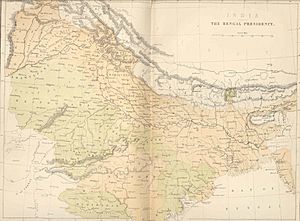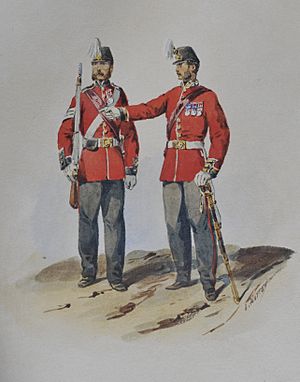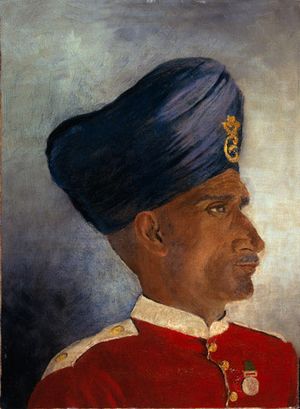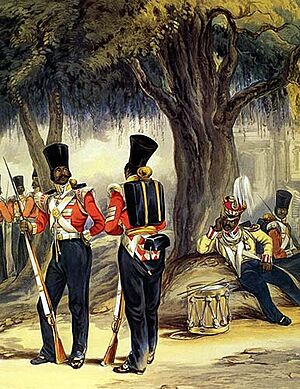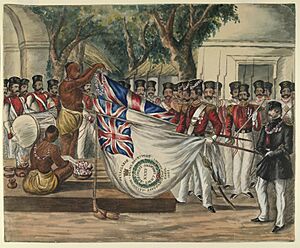Bengal Army facts for kids
Quick facts for kids Bengal Army |
|
|---|---|
 |
|
| Active | 1756–1895 (as the Bengal Army) 1895–1908 (as the Bengal Command of the Indian Army) |
| Branch | Presidency armies |
| Type | Command |
| Size | 105,000 (1876) |
| Garrison/HQ | Nainital, Nainital district (1895–1908) |
The Bengal Army was a large army in British India. It belonged to the East India Company (EIC). This company was a powerful British trading group. The Bengal Army helped the British control a big part of India called the Bengal Presidency.
The armies of the three main British areas in India, called presidency armies, were owned by the East India Company. But after a major uprising in 1857, the British government took direct control. In 1895, the Bengal Army joined with other armies to form the Indian Army.
Contents
History of the Bengal Army
How the Army Started
The Bengal Army began in 1756. Before this, the East India Company had a small group of soldiers. But this group was destroyed when the city of Calcutta was captured.
Under the East India Company
In 1757, the first local Indian soldiers, known as sepoys, joined the army. They were trained and armed like British soldiers. These soldiers fought well in the Battle of Plassey in 1757. By 1764, 20 more Indian battalions (groups of soldiers) were created.
The East India Company kept making its Bengal Army bigger. By 1796, it had many European and Indian soldiers. This included artillery (big guns), cavalry (soldiers on horseback), and infantry (soldiers who fight on foot).
In 1824, the Bengal Army changed its structure. Its infantry was organized into 68 regiments. By the time of the First Afghan War (1839–42), the Bengal Army was very strong. It had more soldiers than the armies from Madras or Bombay. Many people thought the Bengal sepoy was a very good soldier.
A new type of unit, called "irregular" regiments, started in the 1840s. These units had less formal training and fewer British officers. Most of the soldiers in the regular army were high-caste Hindus. The cavalry, however, had many Muslim soldiers.
Before 1845, some regiments were called "Volunteers." This meant their soldiers agreed to serve overseas if needed. Soldiers who were willing to travel by ship received extra pay. Two of these regiments were in China in 1857. This meant they were not involved in the big rebellion that year.
In 1857, the East India Company's Bengal Army had over 150,000 men. Most of these, about 128,000, were Indian soldiers.
The 1857 Rebellion
During the Indian Rebellion of 1857, many Bengal Army regiments rebelled. Some were disbanded because their loyalty was not trusted. After 1858, the army changed who it recruited. Fewer high-caste Hindu soldiers from certain areas were allowed to join. This was because they were seen as the main rebels in 1857.
The new Bengal Army recruited more soldiers from different groups. These included Punjabi Muslims, Sikhs, Gurkhas, Baluchis, and Pathans. The idea was that an army with soldiers from many different backgrounds would be less likely to rebel together.
The End of the Separate Bengal Army
In 1895, the three separate armies of British India began to combine. This process finished in 1903. As a first step, the Army of India was split into four main commands. These included Bengal, Bombay, Madras, and Punjab.
By 1903, the regiments from the Bombay, Madras, and Bengal Armies were all put into one list. Their old regional names disappeared. The Bengal infantry units that existed at this time became the senior regiments of the new unified Indian Army.
Who Joined the Bengal Army?
The Bengal Army of the East India Company mainly recruited soldiers from high-caste families. These families lived in areas like Bihar and Awadh.
Sir John Malcolm, who knew a lot about Indian soldiers, wrote in 1834: "They are mostly Rajputs, a special group. We can tell how tall these men are because no one shorter than five feet six inches is accepted. Many of the best soldiers are six feet tall or more."
Both before and after 1857, the Bengal Army included some very famous units. These included Skinner's Horse from Bengal, the Gurkhas from the Himalayas, and the Corps of Guides.
How the Army Was Organized
The Bengal Army had different types of soldiers. These included cavalry, artillery, and infantry.
Cavalry (Horse Soldiers)
The cavalry units rode horses. They were divided into regular regiments and irregular units.
- Regular regiments included units like the Governor General's Bodyguard. Many of these rebelled in 1857.
- Irregular units were less formal. A famous one was the 1st Irregular Cavalry, also known as Skinner's Horse.
Artillery (Big Guns)
The Bengal Artillery used big guns. It had three main parts:
- Bengal Horse Artillery had cannons pulled by horses.
- Bengal European Foot Artillery had European soldiers.
- Bengal Native Foot Artillery had Indian soldiers.
Engineers
The engineers built things like bridges and roads. The main unit was The Corps of Bengal Sappers and Miners.
Infantry (Foot Soldiers)
The infantry soldiers fought on foot. They were also divided into regular regiments and irregular units.
- Regular regiments included European and Indian soldiers. Many of the Indian regiments rebelled in 1857. Only twelve of the original Indian regiments continued after the rebellion. These kept their traditions, like wearing red coats.
- Irregular units were formed from various local groups. These included units like The Sirmoor Rifle Regiment (which became the Gurkhas) and the Corps of Guides.
Commanders of the Bengal Army
The Bengal Army was the biggest of the three armies in India. Because of this, its main commander was also the Commander-in-Chief, India from 1853 to 1895. After 1895, when the armies started to combine, the Bengal Army had its own commanders.
- Lieutenant-General Sir William Elles (1895–1896)
- Lieutenant-General Sir Baker Russell (1896–1898)
- Lieutenant-General Sir George Luck (1898–1903)
- Lieutenant-General Sir Alfred Gaselee (1903–1907)
See also





